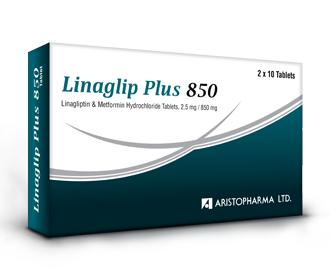
Linaglip Plus 850
Therapeutic Class
Antidiabetic Agents
Indications
Linaglip Plus is indicated as an adjunct to diet and exercise to improve glycemic control in adults with type 2 diabetes mellitus when treatment with both Linagliptin and Metformin is appropriate. Combination of Linagliptin and Metformin is not recommended for treatment of type 1 diabetes or diabetic ketoacidosis and has not been studied in patients with a history of pancreatitis.
Chemical Composition
Each film coated tablet contains Linagliptin INN 2.5 mg & Metformin Hydrochloride BP 850 mg.
Packaging
2*10's/Box for Linaglip Plus 850
Dosage & Administration
- Patients not currently treated with Metformin: Initiate treatment with Linaglip Plus 2.5/500 tablet twice daily. - Patients already treated with Metformin: If patient is taking Metformin 500 mg tablet twice daily, then give him/her Linaglip-Plus 2.5/500 tablet twice daily. If patient is taking Metformin 850 mg tablet twice daily, then give him/her Linaglip-Plus 2.5/850 tablet twice daily. - Patients already treated with Linagliptin and Metformin individual components: May be switched to Linaglip-Pluscontaining the same doses of each component - Maximum recommended dose: 2.5 mg Linagliptin/1000 mg Metformin tablet twice daily.
Contraindications
This combination of Linagliptin & Metformin is contraindicated in patients with renal impairment (e.g., serum creatinine >1.5 mg/dL for men, >1.4 mg/dL for women, or abnormal creatinine clearance), which may also result from conditions such as cardiovascular collapse (shock), acute myocardial infarction, and septicemia. This combination is also contraindicated in case of acute or chronic metabolic acidosis, including diabetic ketoacidosis. Diabetic ketoacidosis should be treated with insulin. In case of a history of hypersensitivity reaction to Linagliptin, such as anaphylaxis, angioedema, exfoliative skin conditions, urticaria, or bronchial hyperreactivity. It is also contraindicated in case of hypersensitivity to Metformin.
Side Effects
Most common side effects of this combination of Linagliptin & Metformin are weakness or tiredness, unusual muscle pain, breathing in trouble, nausea, vomiting, diarrhea, dizziness. Adverse reactions reported in >5% of patients treated with Linagliptin & Metformin combination and more commonly than in patients treated with placebo are nasopharyngitis and diarrhea. Hypoglycemia was more commonly reported in patients treated with the combination of Linagliptin & Metformin and SU compared with those treated with the combination of SU and Metformin.
Drug Interaction
“Drug Interactions with Metformin” - Cationic Drugs: Cationic drugs (e.g., amiloride, digoxin, morphine, procainamide, quinidine, quinine, ranitidine, triamterene, trimethoprim, or vancomycin) that are eliminated by renal tubular secretion theoretically have the potential for interaction with Metformin by competing for common renal tubular transport systems. Although such interactions remain theoretical (except for cimetidine), careful patient monitoring and dose adjustment of Linagliptin & Metformin combination and/or the interfering drug is recommended in patients who are taking cationic medications that are excreted via the proximal renal tubular secretory system. - Carbonic Anhydrase Inhibitors: Topiramate or other carbonic anhydrase inhibitors (e.g., zonisamide, acetazolamide or dichlorphenamide) frequently decrease serum bicarbonate and induce non-anion gap, hyperchloremic metabolic acidosis. Concomitant use of these drugs may induce metabolic acidosis. Use these drugs with caution in patients treated with Linagliptin & Metformin combination, as the risk of lactic acidosis may increase. - Alcohol: Alcohol is known to potentiate the effect of metformin on lactate metabolism. Warn patients against excessive alcohol intake while receiving combination of Linagliptin & Metformin extended release tablet. “Drug Interactions with Linagliptin” - Inducers of P-glycoprotein and CYP3A4 Enzymes: Rifampin decreased Linagliptin exposure, suggesting that the efficacy of Linagliptin may be reduced when administered in combination with a strong P-gp inducer or CYP 3A4 inducer. As Linagliptin & Metformin combination is a fixed-dose combination of Linagliptin and Metformin, use of alternative treatments (not containing Linagliptin) is strongly recommended when concomitant treatment with a strong P-gp or CYP 3A4 inducer is necessary. - Insulin Secretagogues or Insulin Coadministration of Linagliptin & Metformin extended release tablet with an insulin secretagogue (e.g., sulfonylurea) or insulin may require lower doses of the insulin secretagogue or insulin to reduce the risk of hypoglycemia. - Drugs Affecting Glycemic Control Certain drugs tend to produce hyperglycemia and may lead to loss of glycemic control. These drugs include the thiazides and other diuretics, corticosteroids, phenothiazines, thyroid products, estrogens, oral contraceptives, phenytoin, nicotinic acid, sympathomimetics, calcium channel blocking drugs, and isoniazid. When such drugs are administered to a patient receiving combination of Linagliptin & Metformin extended-release tablet, the patient should be closely observed to maintain adequate glycemic control. When such drugs are withdrawn from a patient receiving combination of Linagliptin & Metformin extended-release tablet, the patient should be observed closely for hypoglycemia.

